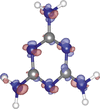issue contents
October 2023 issue

Cover illustration: Crystal structure of oxoborates of the ludwigite group represented in terms of oxo-centered polyhedra in comparison with figures of thermal expansion tensor given at several temperatures. (Mg,Ti)-rich azoproite and Mg-rich ludwigite show positive expansion, while Fe-rich vonsenite exhibits a strong negative expansion due to a magnetism up to ∼120 K and a damped one due to oxidation which occurs above ∼500 K [see Biryukov et al. (2023). Acta Cryst. B79, 368–379].
scientific commentaries
 access
accessresearch papers


 access
access



 access
access





book reviews


 journal menu
journal menu



































